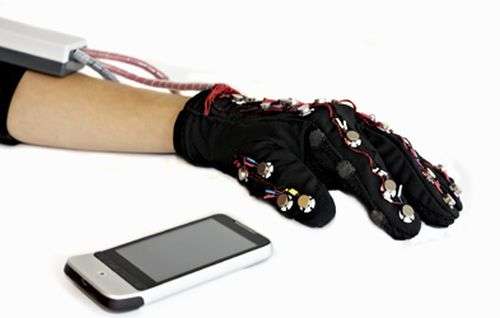April 7, 2012 report
Glove designers plan messaging path for deaf-blind

(Phys.org) -- People coping with the double absence of vision and hearing can communicate via mobile devices with the help of a special glove, now under development in Germany’s Design Research Lab. The Mobile Lorm Glove is a wearable device that lets the user compose messages to be transmitted to the receiver’s smartphone. This same glove allows the deaf-blind user to receive incoming messages as well. Basically, the person who cannot see or hear can use tactile feedback to send and receive communications.
The lab developers tell the story of what kind of difference their glove can make: People who are deaf-blind may depend on a touch sign language alphabet called Lorm that assigns characters to different areas of the hand. Such dependence seriously limits the number of people with whom they can communicate—with others who know Lorm and are within physical contact.
The alphabet gets its name from the creator, a philosopher and poet who lost his hearing at 15 and found that he was losing his sight. To cope,. he came up with a hand touch alphabet for the deaf-blind, and the alphabet eventually became known in some European countries as Lorm's alphabet. Mikulov Heinrich Landesman was the creator’s real name but he had to use the pseudonym Hieronymus Lorm to escape persecution, according to accounts.
What the glove does is resolve the alphabet limits; it translates the Lorm alphabet into digital text and vice versa, using pressure points. Incoming messages are received by small vibrators on the back of the glove, which translate messages into vibrations. Outgoing messages are also served by the glove‘s textile pressure sensors on the palm of the glove. They translate "Lorm" into text or speech via mobile phone. These pressure sensors correspond to the Lorm alphabet to construct the words and sentences.
A Bluetooth module manages the transmission between glove and phone The Bluetooth connection sends data from the glove to the user’s phone. It is forwarded to the receiver’s phone in the form of an SMS. When the glove wearer gets a text message, it is forwarded via Bluetooth from the phone to the glove.
The project was developed at the Design Research Lab by Tom Bieling, Ulrike Gollner and Gesche Joost. The Mobile Lorm Glove is in prototype, and the next phase of research will include direct speech input and output. Eventually, they see the glove as beneficial in broader ways than email and texting. The developers suggest the device will make reading e-books easier, as they put it, “to also ‘feel’ E-Books or Audiobooks."
More information: www.design-research-lab.org/?p … ts=mobile-lorm-glove
© 2012 Phys.Org



















